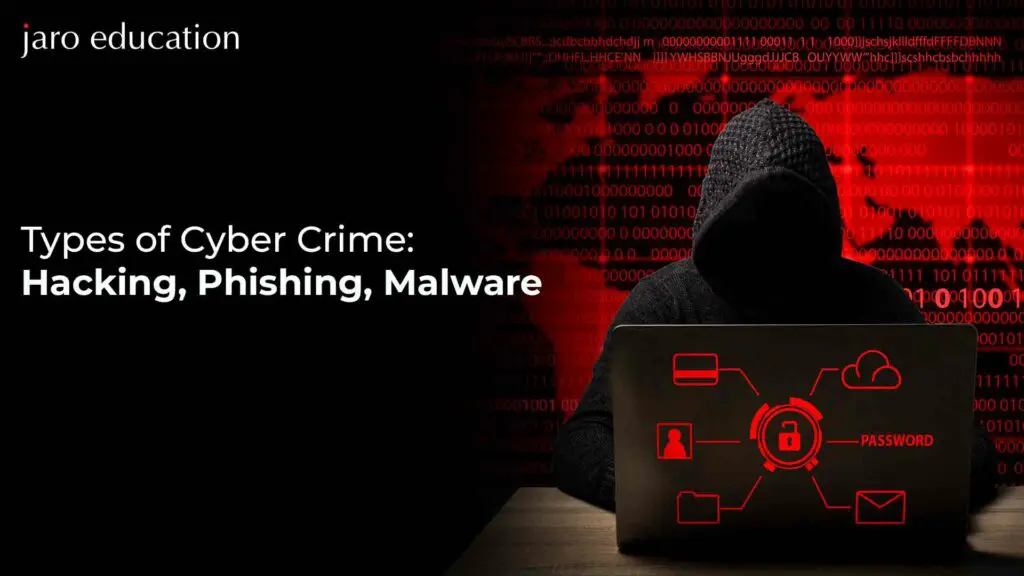Types of Cyber Crime: Hacking, Phishing, Malware
Table of Contents

- jaro education
- 5, July 2023
- 2:33 am
As the world grows more connected, India’s expanding digital landscape has created new opportunities for cybercriminals to exploit weaknesses, sparking an increase in cybercrime throughout the nation.
Organisations need qualified personnel with in-depth cybersecurity knowledge and sophisticated capabilities to combat cybercrime efficiently. Professionals looking to improve their knowledge and skills in protecting businesses against cyber threats can look forward to the Executive Programme in Cyber Security for Organizations (EPCSO) offered by IIM Indore to be a beneficial resource.
This programme provides participants access to a demanding curriculum created to address the most recent cyber crimes in India witnessed by enterprises.
Cyber Crime: The Definition
“Cybercrime” is the term used to describe the improper use of communication technology to engage in or facilitate criminal activity. People, businesses, and even governments are impacted by cybercrimes.
Hackers and other cybercriminals often target financial gain when committing their crimes. Organisations and individuals are both capable of engaging in these illegal practices. In their pursuit of financial gain, cybercriminals often utilise computers or networks to distribute viruses, malware, explicit content, and other illegal data.
Investigators employ different methods to examine devices suspected of being involved in or targeted by cybercrimes.
Types of Cyber Crime
Cybercrime encompasses a wide range of illegal activities conducted in the digital realm. Three prominent types of cybercrime include hacking, phishing, and malware attacks. Let’s know about these in detail.
Hacking
Attempting to obtain unauthorised access to digital devices like computers and smartphones is known as hacking. It is frequently viewed as illegal and is done by cybercriminals for a variety of reasons, including financial gain, political protest, information collecting, etc.
Hacking Tools: Methods Employed by Hackers
- Denial of service attacks
- Botnets
- Browser hijacks
- Ransomware Rootkits
- Viruses
- Trojans
- Worms
Denial of Service (DoS)
Botnets
Browser hijacks
Ransomware Rootkits
Viruses
Trojans
Worms
Phishing
Phishing is a sort of online crime in which a targeted person is approached through email, phone call, or text message by a fraudster. They pretend to be a representative of a reliable organisation to trick people into disclosing sensitive information, including passwords, banking and credit card information, and personal identifiable information (PII).
After that, the data is used to log into crucial accounts, which may lead to identity theft and financial loss.
Understanding Phishing: Mechanics and Risks
Phishing attacks rely on fraudulent emails or communications that deceive victims into providing sensitive information or downloading malware. The dangers of phishing are twofold.
Firstly, attackers can exploit the obtained information for financial gain, such as credit card fraud. Moreover, phishing attacks can serve as a gateway for more sophisticated cybercrimes like advanced persistent threats (APTs) and ransomware, targeting individuals or organisations by obtaining login credentials or other valuable data.
Understanding the mechanics and risks of phishing is crucial in protecting against these malicious activities.
Types of Phishing Attacks
Deceptive Phishing
Spear Phishing
Whaling
Pharming
Malware
The abbreviation “malware,” which stands for “malicious software,” refers to any programme or piece of code developed with the intention of damaging or abusing computer systems, networks, or other technology. Malware comes in the form of viruses, worms, Trojan horses, ransomware, and spyware.
Its goal is to cause harm or disruption, steal confidential information, get unauthorised access, or seize control of a system.
Methods of Malware Infection
Malware authors employ diverse methods, both physical and virtual, to propagate malware and infect devices and networks. Some examples include spreading malicious programs through USB drives, utilising popular collaboration tools, and employing drive-by downloads, where malicious programs are automatically downloaded onto systems without the user’s consent or awareness.
How Does Malware Function?
Malware is created to infect networks and devices with the intention of causing harm to the affected systems and their users. The impact of malware varies depending on its type and objectives. While some malware may have mild or harmless effects, others can lead to severe consequences.
No matter what technique is used, all malware targets devices and, at the expense of the user, benefits the hackers who used it.
Thus, in order to protect yourself from the ever-evolving threats in the digital domain, it is crucial to grasp the knowledge of various types of cybercrime, such as hacking, phishing and malware, as it has now become essential for people and organisations to equip themselves with the skills and information necessary to ward off such attacks.












1 thought on “Types of Cyber Crime: Hacking, Phishing, Malware”
This article offers a comprehensive overview of different types of cybercrime. It’s a must-read for anyone interested in cybersecurity!